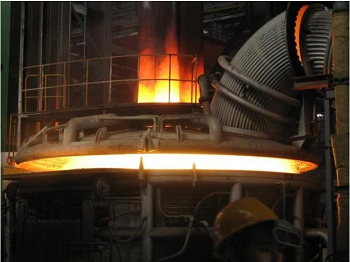Non-blast furnace ironmaking
1. Tunnel kiln technology
The tunnel kiln process is relatively simple, the technical content is low, and the raw materials, reducing agents, and fuels are easy to solve. The process has strong practicability, small early investment, and is suitable for small-scale production. It is a metallurgical reduction production process commonly used in the powder metallurgy industry. However, tunnel kilns have a small single-unit production capacity, low degree of automation, high labor intensity, high energy consumption, and large environmental pollution. Moreover, due to their small scale and outsourcing of raw materials, they cannot be guaranteed to have a stable supply and have large fluctuations in product quality. They are rarely used in the production of steelmaking sponge iron. The high energy consumption and environmental protection of tunnel kilns are important issues for their survival and development.
2. Rotary kiln process
Most of the coal-based reduction technologies commonly used in the world are rotary kilns "two-step method". The reduction process of adding oxidized pellets or high-grade lump ore into the rotary kiln is adopted. The "one-step" process uses cold consolidated pellets or pre-dried pellets to be directly added to the rotary kiln for reduction roasting. Due to insufficient pellet strength and prominent pulverization problems, it faces certain production and operation problems.
The rotary kiln method has high requirements for raw fuel, needs a stable operation, has certain economic strength, and has resources advantages of small and medium-sized enterprises can choose this process.
As the rotary kiln is common metallurgical equipment and is easy to obtain, the direct reduction technology of rotary kiln has been widely used in dust and mud treatment of steel mills, zinc oxide production from zinc-containing slag, reduction of titanium concentrate, and direct reduction of laterite nickel ore to produce ferronickel. In recent years, the rotary kiln direct reduction process has also been applied to chromium ore reduction and titanium concentrate reduction production and has achieved very good production results.
3. Rotary hearth furnace process
The rotary hearth furnace production line is used for comprehensive utilization of composite ore, utilization of iron-containing dust, production of pre-reduced furnace burden, etc. The reason for the rotary bottom furnace process is that due to the infiltration of coal ash, the iron grade of the product is relatively low, generally about 70%-80%, and the S is high. The application of the rotary bottom furnace process focuses on the treatment of steel mill wastes such as blast furnace sludge or dust removal ash.
4. Coal-based shaft furnace process
Coal-based shaft furnaces have been paid attention to by the industry because their output can be expanded and they have scale advantages. The indexes of some experimental factories can meet the steelmaking standards. Many enterprises are carrying out industrial tests on coal-based shaft furnaces. The coal-based shaft furnace has simple production operation, can realize full automatic control, and has high production stability, few vulnerable parts, and small maintenance.
5. Gas base shaft furnace
The gas-based shaft furnace direct reduction process is the mainstream direct reduction process in the world today. The proportion of sponge iron produced by the gas-based shaft furnace direct reduction process in the world is ≥ 75%. The obvious advantages of a gas-based shaft furnace are the large output of a single set of equipment, no consumption of coking coal, energy saving, environmental friendliness, low energy consumption, and low CO2 emission. Gas-based reduction technology is supported by policies due to its role in energy conservation, emission reduction, low carbon, and environmental protection. Gas-based reduction technology is an advanced ironmaking technology with excellent product quality in low-carbon life, and it should become the main development direction of direct reduction ironmaking technology.
6. Smelting reduction process
The smelting reduction ironmaking process saves sintering and coking, which can save a lot of investment and operation cost under the same production capacity, and the product is also molten iron, so it has attracted much attention from iron and steel enterprises.







